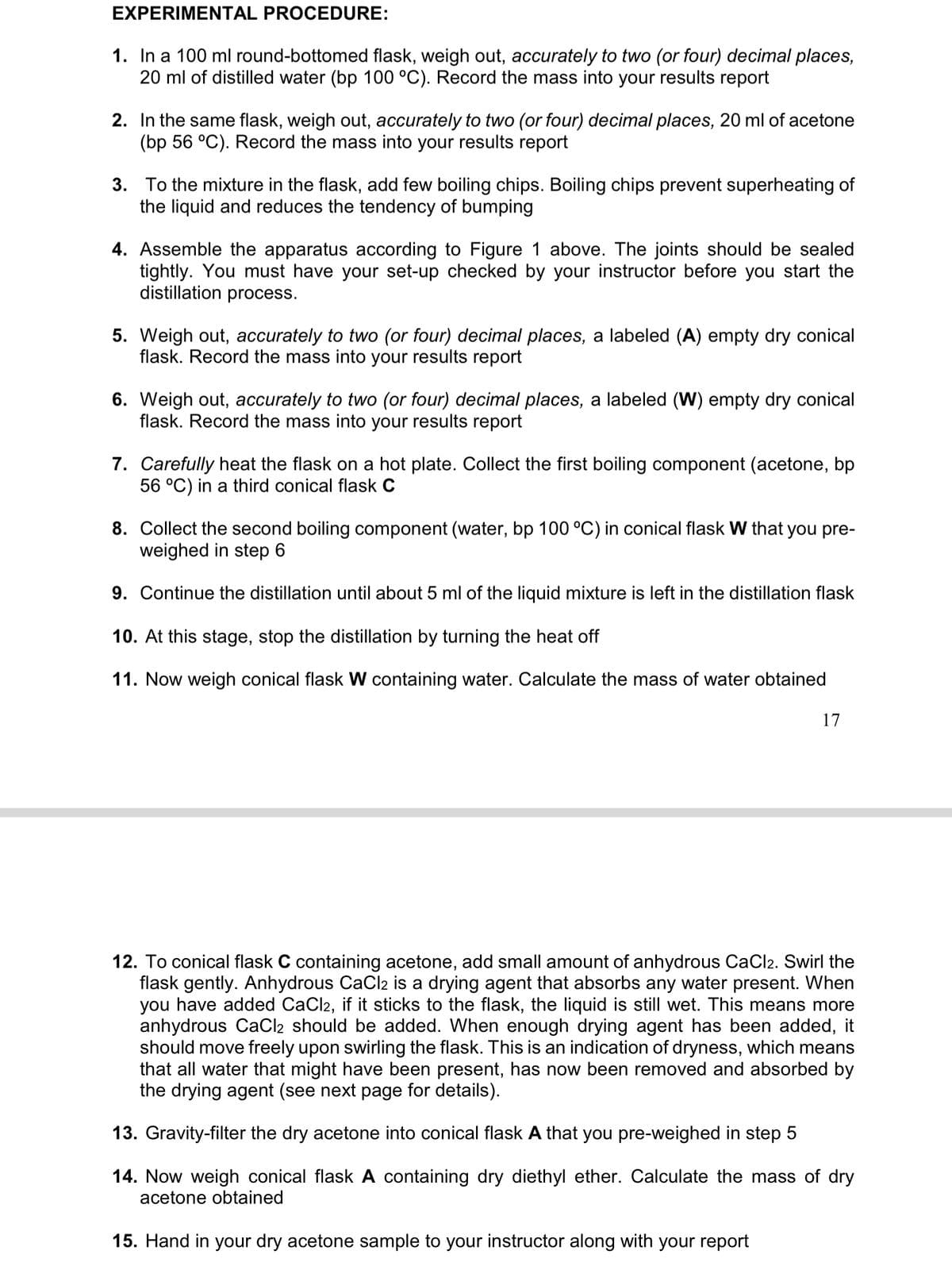Introductory Chemistry: An Active Learning Approach
6th Edition
ISBN:9781305079250
Author:Mark S. Cracolice, Ed Peters
Publisher:Mark S. Cracolice, Ed Peters
Chapter2: Matter And Energy
Section: Chapter Questions
Problem 35E
Related questions
Question
Simple and fractional distillation

Transcribed Image Text:EXPERIMENTAL PROCEDURE:
1. In a 100 ml round-bottomed flask, weigh out, accurately to two (or four) decimal places,
20 ml of distilled water (bp 100 °C). Record the mass into your results report
2. In the same flask, weigh out, accurately to two (or four) decimal places, 20 ml of acetone
(bp 56 °C). Record the mass into your results report
3. To the mixture in the flask, add few boiling chips. Boiling chips prevent superheating of
the liquid and reduces the tendency of bumping
4. Assemble the apparatus according to Figure 1 above. The joints should be sealed
tightly. You must have your set-up checked by your instructor before you start the
distillation process.
5. Weigh out, accurately to two (or four) decimal places, a labeled (A) empty dry conical
flask. Record the mass into your results report
6. Weigh out, accurately to two (or four) decimal places, a labeled (W) empty dry conical
flask. Record the mass into your results report
7. Carefully heat the flask on a hot plate. Collect the first boiling component (acetone, bp
56 °C) in a third conical flask C
8. Collect the second boiling component (water, bp 100 °C) in conical flask W that you pre-
weighed in step 6
9. Continue the distillation until about 5 ml of the liquid mixture is left in the distillation flask
10. At this stage, stop the distillation by turning the heat off
11. Now weigh conical flask W containing water. Calculate the mass of water obtained
17
12. To conical flask C containing acetone, add small amount of anhydrous CaCl2. Swirl the
flask gently. Anhydrous CaCl2 is a drying agent that absorbs any water present. When
you have added CaCl2, if it sticks to the flask, the liquid is still wet. This means more
anhydrous CaCl2 should be added. When enough drying agent has been added, it
should move freely upon swirling the flask. This is an indication of dryness, which means
that all water that might have been present, has now been removed and absorbed by
the drying agent (see next page for details).
13. Gravity-filter the dry acetone into conical flask A that you pre-weighed in step 5
14. Now weigh conical flask A containing dry diethyl ether. Calculate the mass of dry
acetone obtained
15. Hand in your dry acetone sample to your instructor along with your report

Transcribed Image Text:Q5. Which distillation technique is more efficient, simple or fractional? Explain briefly.
Expert Solution
This question has been solved!
Explore an expertly crafted, step-by-step solution for a thorough understanding of key concepts.
This is a popular solution!
Trending now
This is a popular solution!
Step by step
Solved in 2 steps

Knowledge Booster
Learn more about
Need a deep-dive on the concept behind this application? Look no further. Learn more about this topic, chemistry and related others by exploring similar questions and additional content below.Recommended textbooks for you

Introductory Chemistry: An Active Learning Approa…
Chemistry
ISBN:
9781305079250
Author:
Mark S. Cracolice, Ed Peters
Publisher:
Cengage Learning

Introductory Chemistry: An Active Learning Approa…
Chemistry
ISBN:
9781305079250
Author:
Mark S. Cracolice, Ed Peters
Publisher:
Cengage Learning